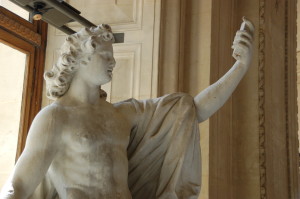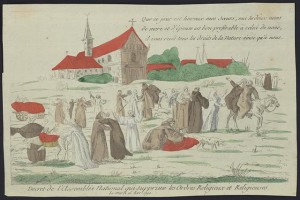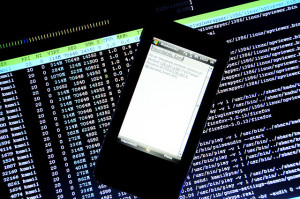On December 12, 2015, Brahim Zaibat, a dancer and choreographer, posted on social media a selfie he had taken two years ago, showing him in an airplane, just a seat behind the one where Jean-Marie Le Pen, the honorary president of the French National Front, had fallen asleep.
Mr. Zaibat wrote under the selfie: “Put them KO tomorrow by going to vote. To preserve our fraternal France !!! ” Mr. Zaibat was referring to the second round of France’s regional elections, which were to take place the next day, on December 13, 2015, as the National Front, a party on the far right, was leading in the first round of the election in six of the thirteen French regions.
Mr. Le Pen took umbrage at this photograph as he considered it to be an infringement of his privacy and of his right to his image (droit à l’image). He sued Mr. Zaibat on December 31, 2015, and asked the Tribunal de Grande Instance (TGI) of Paris, sitting in emergency, to order the selfie to be taken down from the social media site, to order the publication in several magazines of a message informing the public about this judicial measure, and to order Mr. Zaibat to pay a provisional fine of 50,000 euros.
Mr. Zaibat argued in defense that ordering his selfie to be removed would undermine his freedom of expression as protected by article 10 of the European Convention on Human Rights (ECHR). According to Mr. Zaibat, he had “not overstepped the limits of freedom of expression, in a humorous way, in the context of a political debate on a topic of general interest.” For Mr. Zaibat, the selfie was a photograph taken in public, which represented, in a humorous way, a politician whose party was then in the spotlight.
But the judge, quoting both article 9 of the French civil Code, and article 8 of the ECHR, both protecting privacy, considered that the selfie indeed had violated Mr. Le Pen’s privacy and the right to his image. But she considered that since the selfie was “neither degrading nor malicious,” it was appropriate to award the politician only one euro compensation. However, the judge forbade Mr. Zaibat to republish the photograph under penalty of 1,000 euros per infringement.
Mr. Zaibat has appealed the interim order.
No legal definition of privacy
Article 9 of the French civil Code provides that “[e]veryone has the right to respect for his private life” but it does not define what privacy is. Similarly, article 8 of the ECHR guarantees the right to respect for private life, without defining that concept. In 1970, the Parliamentary Assembly of the Council of Europe defined the right to respect for privacy in its declaration on mass communication media and human rights, Resolution 428, as “consist[ing] essentially in the right to live one’s own life with a minimum of interference” which includes “non-revelation of irrelevant and embarrassing facts, unauthorized publication of private photographs.”
Freedom of expression
Article 10 of the ECHR protects freedom of expression, which may nevertheless, under Article 10-2 of the Convention, “be subject to such formalities, conditions, restrictions or penalties as are prescribed by law and are necessary in a democratic society.” The Court interpreted this text in 1979, in Sunday Times v. The United Kingdom, as requiring that such measures necessary in a democratic society must correspond to a pressing social need, which must be proportionate to the legitimate aim pursued. Furthermore, the reasons given by the national authorities to justify such measures must be relevant and sufficient (see Sunday Times v. The United Kingdom § 62).
The difficult balance between freedom of expression and protection of privacy
The selfie violates the privacy of Mr. Le Pen. But does his right to privacy necessarily prevail over the right of Mr. Zaibat to express himself and over the public’s right to be informed?
It can be argued that a public person has the right to fall sleep on an airplane without having his picture taken and the photo published. Mr. Le Pen had argued in court that Mr. Zaibat was not a political debater or a comedian, but a dancer, and thus could not avail himself of free political expression, but that he had “in fact expressed himself as a private citizen and had simply taken advantage of the political agenda to create some “buzz ” by broadcasting a stolen photograph taken two years before.” But freedom of opinion belongs to everyone, dancers, politicians, and media.
In a recent judgment, Couderc and Hachette Filipacchi Associés v. France, the Grand Chamber of the European Court of Human Rights unanimously held that France had violated Article 10 of the ECHR when interfering in 2005 with the right of weekly magazine Paris Match to publish photos of the then secret son of Prince Albert of Monaco.
In Couderc, the Court observed that “[t]he right to the protection of one’s image is… one of the essential components of personal development. It mainly presupposes the individual’s right to control the use of that image, including the right to refuse publication thereof” (Couderc § 85).
The Court added:
“In determining whether or not the publication of a photograph interferes with an applicant’s right to respect for his or her private life, the Court takes account of the manner in which the information or photograph was obtained. In particular, it stresses the importance of obtaining the consent of the persons concerned, and the more or less strong sense of intrusion caused by a photograph… In this connection, the Court has had occasion to note that photographs appearing in the “sensationalist” press or in “romance” magazines, which generally aim to satisfy the public’s curiosity regarding the details of a person’s strictly private life… are often obtained in a climate of continual harassment which may induce in the person concerned a very strong sense of intrusion into their private life or even of persecution” (Couderc § 86).
What about the picture taken by Mr. Zaibat? Does it represent Mr. Le Pen in his private life or in his public life? Mr. Le Pen is a public person. The photo was taken in a public place, an airplane, without the subject of photography being harassed. All persons in the aircraft could see Mr. Le Pen asleep in his seat, if passing by him in the aisle. But does the public have the right to know that he was asleep in this plane?
The judge took the position to subjectively define privacy as the sphere that the person herself defines when determining what can be disclosed by the press.
“In accordance with Article 9 of the Civil Code and Article 8 of the [ECHR] every person, regardless of his reputation, has a right to privacy and is entitled to get protection by setting herself what may be disclosed by the press. ”
But this is an “extreme” conception of privacy according to three law professors (Traité du Droit de la Presse et des Medias, Bernard Beignier, Bertrand De Lamy, and Emmanuel Dreyer, paragraph 1589). The authors note that this conception allows an individual to “oppose any publication even in the presence of a legitimate public interest.” According to the authors, this conception of privacy is “not viable.”
In a case with facts somewhat similar to ours, François Hollande, then First Secretary of the French Socialist Party, was photographed in 2006 while on vacation, in a market in the South of France. The photos were published in a weekly magazine which illustrated them with humorous comments referring to current events. Mr. Hollande sued the magazine for invasion of privacy. The Cour de Cassation, France’s highest civil court, ruled on October22, 2007, that the photos indeed had interfered with the privacy of Mr. Holland:
“Whereas the limits of the protection afforded by article 9 of the civil Code can be interpreted more widely in respect of persons performing official and public functions, the information revealed in this case are not directly related to the political functions exercised by the applicant as the photographs were taken on the occasion of a private activity carried out during his vacation; these elements are therefore not within a legitimate public information, despite the humorous reference in the article to the next organization by François Hollande of a conference on the purchasing power of the French.
Did Mr. Zaibat participate in a debate of general interest by publishing the selfie? In its judgment in Von Hannover v. Germany (n. 2), the European Court of Human Rights explained that:
“an initial essential criterion is the contribution made by photos or articles in the press to a debate of general interest… the definition of what constitutes a subject of general interest will depend on the circumstances of the case“ (Von Hannover v. Germany (n. 2) § 109).
Yet, after its Couderc case of November 2015, the European Court of Human Rights seems to tip the balance in favor of freedom of expression. However, the French courts are often more favorable to the protection of privacy. Stay tuned…
Image is courtesy of Flickr user Gautier Poupeau under a CC BY 2.0 license.





